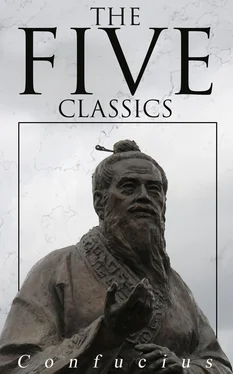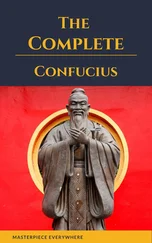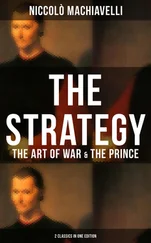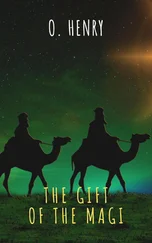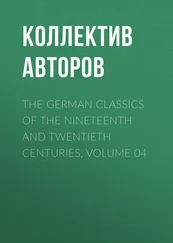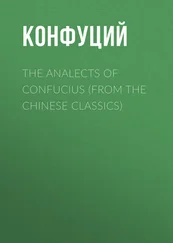Paragraph 3 is also tantalising. Why does the writer introduce the subject of punishments and penalties? Are they a consequence of putting the hosts in motion?
18.The trigrams K ăn and Tui are distinguished as strong and weak, K ăn representing, on king Wăn's scheme, 'the eldest son,' and Tui, 'the youngest daughter.' But 'the strong' here may mean the strong line, the lowest in the hexagram. As Wang Ȝung- kw an (Sung dynasty) says:--'The yang and strong line should not be below a yin and weak line, as we find it here. That is, in Sui the high places himself below the low, and the noble below the mean:'--esteeming others higher than himself, and giving the idea of following. Then K ân denotes the production or excitement of motion, and Tui denotes pleasure; and the union of these things suggests the same idea.
19.The symbolism here is the opposite of that in Sui. The upper trigram K ăn is strong, denoting, according to king Wăn, 'the youngest son;' and the lower, Sun, is weak, denoting 'the eldest daughter.' For the eldest daughter to be below the youngest son is eminently correct, and helps to indicate the auspice of great success. The attribute of Sun is pliancy, and that of K ăn stoppage or arrest. The feeble pliancy confronted by the arresting mountain gives an idea of the evil state implied in Kû.
'Three days before and after the turning-point' is, literally, three days before and after k iâ,' k iâ being the name of the first of the 'earthly stems' among the cyclical characters. Hence it has the meaning of 'beginning,' and here denotes the turning-point, at which disorder gives place to order. According to 'the procedure of Heaven,' history is a narrative of change, one condition of affairs constantly giving place to another and opposite. 'A kingdom that cannot be moved' does not enter into the circle of Chinese ideas.
20.See what has been said on the fourth paragraph in pp. 98, 99 on the Text. The other paragraphs need no explanation beyond what appears in the supplemented translation.
21.'The great Manifester' is the ruler, the principal subject of the hexagram, and represented by line 5, near the top of the figure. In that figure the lower trigram. is Kh wăn, representing the earth, with the attribute of docility, and the upper is Sun, representing wind, with the attributes of flexibility and penetration. As is the place of line 5, so are the virtues of the ruler.
'The spirit-like way of Heaven' is the invisible and unfathomable agency ever operating by general laws, and with invariable regularity, in what we call nature. Compare with this paragraph, the definition of Shăn or Spirit in Appendix III, i, 32; and the doctrine of the agency of God, taught in Appendix VI, 8, 9.
22.The 'equal division of the strong and weak lines' is seen by taking them in pairs, though the order in the first pair is different from that in the two others. This is supposed to indicate the intelligence of the judgments in the action of the hexagram. K ăn, the lower trigram, symbolises movement; Lî, the upper, intelligence. The fifth line's acting in its high position does not intimate the formation of the figure from Yî, the 42nd hexagram, but calls attention to the fact that a weak line is here 'lord of judgment.' This does not seem natural, but the effect is good;--judgment is tempered by leniency.
23.The first paragraph is either superfluous or incomplete.
The language of paragraph 2 has naturally been pressed into the p. 232 service of the doctrine of changing the figures by divining manipulation; see p. 219, on paragraph 2 of the Thwan of hexagram 6. But as the Khang-hsî editors point out, 'the weak line coming and ornamenting the two strong ones' simply indicates how substantiality should have the help of ornament, and 'the strong line above (or ascending) and ornamenting the two weak lines' indicates that ornament should be restrained by substantiality. Ornament has its use, but it must be kept in check.--The closing sentence has no connexion with what precedes. Some characters are wanting, to show how the writer passes on to speak of 'the ornamental figures of the sky.' The whole should then be joined on to paragraph 3. The 'figures of the sky' are all the heavenly bodies in their relative positions and various movements, producing day and night, heat and cold, &c. The observances of society are the ceremonies and performances which regulate and beautify the intercourse of men, and constitute the transforming lessons of sagely wisdom.
24.'The symbolic figures in the hexagram' are Khwăn, below, the representative of docility, acting as circumstances require; and Kăn, the representative of a mountain, which arrests the progress of the traveller. The superior man of the topmost line thus interprets them, and acts accordingly. Yet he is not left without hope. Winter is followed by spring; night is p. 233 succeeded by day; the moon wanes, and then begins to wax again. So will it be in political life. As we read in the Hebrew prophet Isaiah, 'In returning and rest shall ye be saved; in quietness and in confidence shall be your strength.'
25.'The movement of the heavenly revolution' in paragraph 3 has reference to the regular alternations of darkness and light, and of cold and heat, as seen in the different months of the year. Hâu Hsing-kwo (of the Thang dynasty) refers to the expressions in the Shih, I, xv, ode 1, 'the days of (our) first (month), second (month),' &c., as illustrating the use of day for month, as we have it here; but that is to explain what is obscure by what is more so; though I believe, as stated on the Text, that seven days' is here equivalent to 'seven months.'
'The mind of heaven and earth' is the love of life and of all goodness that rules in the course of nature and providence.
26.The advocates of one trigram's changing into another, which ought not to be admitted, we have seen, into the interpretation of the Yî, make Wû Wang to be derived from Sung (No. 6), the second line there being manipulated into the first of this; but this representation is contrary to the words of the text, which make the strong first line come from the outer trigram, i. e. from Kh ien. And so it does, as related, not very intelligibly, in Appendix V, 10, K ăn, the lower trigram here, being the eldest son,' resulting from the first application of Khwăn to Kh ien. The three peculiarities in the structure of the figure afford the auspice of progress and success; and very striking is the brief and emphatic declaration, that such progress is 'the appointment of Heaven.'
27.In paragraph 1, Tâ Kh û evidently means the 'grand accumulation' of virtue, indicated by the attributes of its component trigrams. 'Substantial solidity' may very well be given as the attribute of mountains.
'The strong line in the highest place' of paragraph 2 is line 6, whose subject is thus above the ruler represented by 5, and has the open firmament for his range in doing his work. This, and his ability to repress the strongest opposition, show how he is supported by all that is correct and right.
In a kingdom where the object of the government is the accumulation of virtue, good and able men will not be left in obscurity.
What will not a high and good purpose, supported by the greatest strength, be able to do?
28.Many of the critics, in illustration of paragraph 1, refer appropriately to Mencius, VI, i, chap. 14.
In illustration of paragraph 2 they refer to the times and court of Yâo and Shun, sage rulers, from whose cherishing and nourishing came Yü to assuage the waters of the deluge, Ȝî to teach the people agriculture, Hsieh as minister of instruction, Kâo Yâo as minister of crime, and others;--all to do the work of nourishing the people.
Читать дальше
